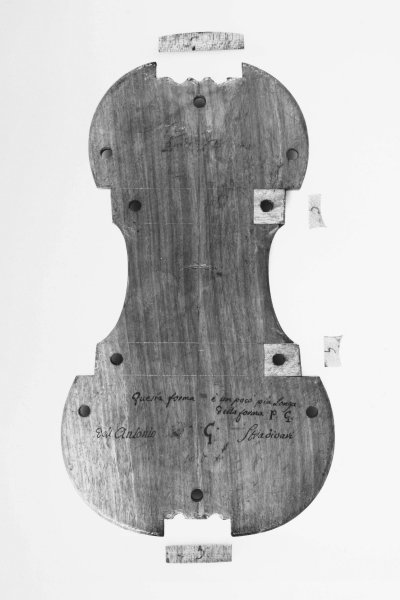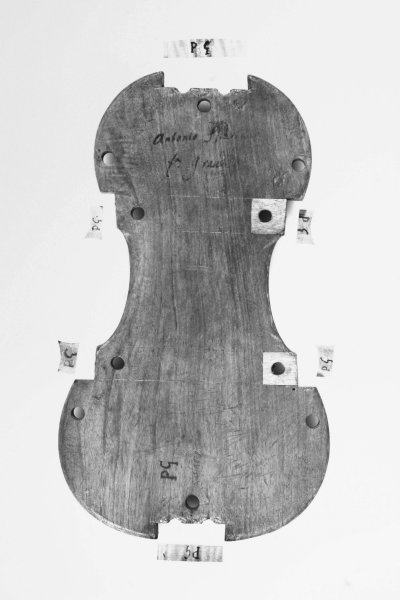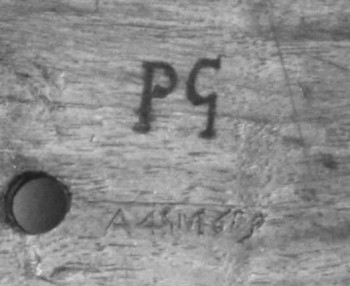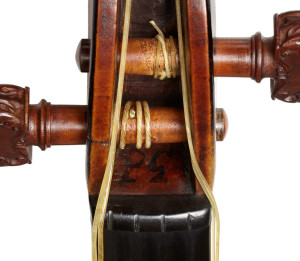Mould photographs reproduced by kind permission of Stewart Pollens, author of ‘The Violin Forms of Antonio Stradivari’ (London 1992). Please note that these photographs are not necessarily to scale and are for illustrative purposes only.
Antonio Stradivari made his violins by utilising a thick (c. 14 mm) wooden mould or ‘form’, to which the four C-bout corner blocks, together with the top and bottom blocks, were lightly glued, and around which the thin lengths of rib were shaped and then strongly glued to the blocks. Simplistically, once all the glue had dried, the ‘garland’ of blocks and ribs could be carefully detached from the inner mould, and the front and back plates could then be attached to the garland to create the soundbox. Although Stradivari’s moulds, made of walnut wood, have varying lengths, widths and proportions, these variations are often by no more than a few millimetres (not that Stradivari, or anyone else, knew anything about millimetres as a unit of measurement) and sometimes the difference between a particular measurement on one mould and the same measurement on another is just one millimetre; for example, the three bout-width measurements of the P mould, and those of the PG mould, are identical, while the body lengths differ by just one millimetre: P mould 343.5 mm; PG mould 344.5 mm (Stewart Pollens’s measurements).

The G mould is inked rather than inscribed ‘G’, as Cozio noted in his inventory. Mould photographs all courtesy Stewart Pollens
Almost all the moulds bear identifying letters, inked or incised in block capitals: for example, the letters P, S, and T (possibly indicating Prima, Seconda, Terza), G (Grande?), PG (Poco Grande or Più Grande?),and MB (Modello Buono?). Because there are so few extant documents known to be written in Stradivari’s hand, it is not certain which, if any, of these mould letters were drawn by him. Some of the moulds have dates, also inked or incised into the surface of the wood: the mould marked SL is dated (in translation) November 9, 1691 (incised), and one of the two moulds marked S is dated September 20, 1703. The two B moulds are dated June 3, 1692 and December 6, 1692 (both incised), while the PG mould is dated June 4, 1689 (also incised).
Count Ignazio Alessandro Cozio di Salabue owned some of Stradivari’s moulds, obtained from Paolo Stradivari and his son, Antonio (II) Stradivari. On February 27, 1823 Cozio began writing an inventory of the moulds (Biblioteca Statale, Cremona, Cozio MS 72, but not included in Renzo Bacchetta’s 1950 Carteggio transcription):
Nota ossia inventaro
Delli modelli, forme di legno, e ferri particolari dell Anto Stradivari e dell Amati che si aggiungerebbero alla Collezione delle instrumenti di Antonio Stradivari
Note, or inventory, of the models, forms [moulds] of wood, and individual tools of Anto Stradivari and of Amati which are added to the Collection of the instruments of Antonio Stradivari
The first page of this inventory begins by describing three cello moulds: (1) ‘large, with nine holes’, (2) ‘much smaller’ and ‘marked V.G in the upper part’, and (3) a ‘viola da gamba’ mould with ‘six holes in the upper part and three in the lower part’. Cozio then describes two viola moulds: CV (Contralto Viola) and TV (Tenor Viola).
The second page of the inventory begins:
Forme da violini di d[ett]o Anto Stradivari. Fatte di legno di noce ripiene e con dieci buchi per l’uso di cui si espresse [?] per quelle da viole
Forms of violins of the aforementioned Antonio Stradivari. Made of solid walnut wood with ten holes for use of which […?] for those of violas

Stradivari’s PG mould, which is slightly shorter than the G one
Cozio describes seven violin moulds in total, which are identified by him as G, PG, B (June 3, 1692), B (December 6, 1692), SL (November 9, 1691), S (September 20, 1703) and P . Cozio’s description of the G mould (BSCr. Cozio MS 72) is:
No 1: Forma segnata con l’inchiostro colla lettera G (quale è un poco più lunga della seg[na]ta PG senza che vi ci possa più scoprire l’indicazione dell ‘epoca di sua formazione della quale se ne vede averne fatto molto uso
No.1: Form marked with ink with the letter G. This is a little longer than [the one] marked PG. Without anything further which would indicate the date of its making, and which has clearly been used many times
Cozio’s description of the PG mould is:
No 2: forma, di cui pure se ne vede fatto molto uso Scolpitavi in essa le lettere P.G. A.4 SM. 1689. (forma più grande – – – –
No.2: mould which has also clearly been used many times, Carved in this are the letters PG A 4 SM 1689 (larger mould – – – –
The PG mould in fact has the text ‘A4GIV1689’cut into its surface, which indicates ‘Anno, 4 Giu[gno], 1689’. Cozio’s misunderstanding of the inscription has been brought about by the very close positioning, and shaping, of some of the letters and numbers cut into the surface of the mould (their precision suggests that the incisions may have been carried out with metal punches). Cozio has mis-transcribed the letter ‘G’ as an ‘S’, and misunderstood ‘IV1’, transcribing it as the letter ‘M’. In addition, he has ‘double counted’ the ‘1’ as both the final vertical stem of his letter ‘M’ and the first numeral of ‘1689’.

The inscription of the PG mould reads ‘A4GIV1689’, not ‘A4SM1689’ as Cozio mistakenly transcribed
The third Carteggio description is:
No 3: forma di cui si vede averne fatto pochissimo uso poco più lunga della sud[etta] PG ma più ristretta nelle parti superiori ed inferiori colla incisione dicente: 1692 A di 3. GIVGNO. B
No.3: mould which can be seen to have had very little use. Slightly longer than the aforementioned PG but narrower in the upper and lower parts [bouts] with an incised [date] reading: 1692 A[nno] di 3 JUNE. B
Cozio’s descriptive comparison of the length and proportion of the PG mould and the B mould of June 3, 1692 is correct according to Stewart Pollens’s measurements:
PG mould: upper bout 161 mm; centre bout 102 mm; lower bout 200 mm; mould length 344.5 mm
B mould: upper bout 154 mm; centre bout 102 mm; lower bout 194.5 mm; mould length 348 mm
Following the death of Cozio in December 1840, his banker, Giuseppe Carli, drew up an inventory of the unsold instruments and workshop items (May 1841). The inventory states that ‘three wooden cello moulds of various dimensions’ and ‘three wooden violin moulds of various dimensions’ were still being held at the Carli offices. Whether these six moulds were specifically Stradivari ones and whether they had previously been included in Cozio’s February 1823 inventory of 12 moulds is unclear. The 1841 (Carteggio) correspondence between Carli and Countess Matilde (Cozio’s daughter) strongly suggests that the six moulds were subsequently returned to the family’s Castello di Salabue residence.
Matilde died in 1855, after which the Salabue family’s remaining instruments and artefacts were inherited by her cousin, Rolando Giuseppe Dalla Valle (Marchese di Pomaro, Lù e Mirabello) of Turin. In 1881 at least 19 (and perhaps as many as 30) items from the Dalla Valle collection were loaned to the National Italian Exhibition, which took place in Milan. According to Federico Sacchi (Count Cozio di Salabue, a biographical sketch, 1898, Note 15, p. 22) the exhibition was visited by Edward J. Payne: ‘It was on this occasion that Mr. Payne copied from Strad’s models the various inscriptions which he published in his article on Stradivari in Sir George Grove’s Dictionary of Musicians’ [first edition, Volume III (1883), pp. 724–734]. In that article Payne states that ‘The Della Valle collection includes […] no less than eleven violin moulds’ (which suggests that one or more pages are missing from Cozio’s MS 72 document) and provides copious first-hand detail about these moulds, specifically identifying the SL, S, P, and T violin moulds, both of the B moulds (as well as the viola CV and TV moulds and ‘another tenor [viola] mould’), as well as ‘a mould for a child’s violin with the blocks attached’. Strangely, Payne makes no mention of the G or the PG violin moulds. Payne acknowledges the help given to him in the writing of his 1883 Grove article by ‘the members of the firm of W.E. Hill & Sons’.

The inscription ‘PG’ in the pegbox of the ‘Lady Blunt’ Stradivari. Photo: Robert Bailey, Tarisio
Before the close of the 19th century one or more of the Hill family of violin dealers traveled to Italy. In their 1902 Stradivari monograph (p. 195) the Hill brothers write: ‘Examination of the moulds possessed by the Marchese Dalla Valle (there are nineteen, three of which are for tenors [violas]) […]’. Subsequently, in the same monograph (p. 206), they reiterate their identification of both number and type of moulds: ‘As previously mentioned, the moulds number nineteen, of which sixteen are for violins and three for violas.’ The Hills’ statements regarding the number of Stradivari moulds and their type sit against Payne’s evidence; in addition, Payne states in 1883 that ‘in 1716 [Stradivari] made new models [moulds] for a violoncello (Della Valle Collection, no. 16)’ but the Hills (1902, p. 206) state that ‘those [moulds] required for viols and for violoncellos are not extant’.
After the death of Rolando Giuseppe Dalla Valle on February 22, 1891 some of the inherited artefacts passed to his youngest son, Rolando Alessandro. The Introduction to Renzo Bacchetta’s Carteggio transcription of Cozio’s papers includes the text of a letter dated September 22, 1948, written by Paola Dalla Valle (1864–1950), surviving wife of Alessandro:
Nella divisione del patrimonio Salabue fra le famiglie Davico, Dalla Valle, Annibaldi, residui di violini toccarono al M.se R. Alessandro Dalla Valle ed ebbe anche le forme…
In the distribution of the Salabue inheritance among the Davico, Dalla Valle and Annibaldi families, the remaining violins came down to Marchese R. Alessandro Dalla Valle and he also received the moulds…
The ‘distribution’ to which Paola refers must be that which was made after the death of her father-in-law in 1891.
Perhaps it was not until after the publication of their 1891 Le Messie monograph that the Hills traveled to Italy to examine the moulds possessed by Dalla Valle, but in the 1902 edition of their Stradivari monograph they specify no date for their trip, nor their precise destination, nor, for certainty of identification, the complete name of Dalla Valle. In the Preface to the 1902 edition the Hills express their gratitude (p. viii):
To the Marquis dalla Valle we are under an exceptional debt of gratitude for having freely accorded us access to his unique collection of Stradivari relics.
This 1902 Preface is apparently replicated in the 1909 second edition of the monograph but a comparison reveals that some of the 1902 text is omitted from the second edition and the expression of gratitude is reworded:
To the late Marquis Alessandro Dalla Valle we are under an exceptional debt of gratitude for having freely accorded us access to his unique collection of Stradivari relics.
If both of the Hills’ expressions of gratitude refer to Rolando Alessandro (d. 1905) then the Hills’ visit to Italy took place after the 1891 death of Rolando Giuseppe Dalla Valle. It is curious that the Hills’ 1902 (and identical 1909) information regarding mould letters – ‘Several have Stradivari’s writing or markings on them – the date when constructed, and letters such as S., L., or B., the object of which seems to have been to identify the patterns belonging to a given form, all of which were similarly lettered’ – should be limited to just three examples (and it should be noted that there is no extant Stradivari mould which has a single letter L inked or inscribed in its surface).
In 1893 a collection of more than 350 workshop items – moulds, patterns and various tools – was donated to the town of Cremona by Giovanni Battista Cerani. This collection apparently originated with Giacomo Stradivari (1822–1901) subsequently passing through the hands of Enrico Ceruti (1806–1883). A letter which accompanied the donation claimed that some of the items were acquired from the descendants of Paolo Stradivari (d. 1775) while others apparently came from the workshop of Lorenzo Storioni (1744–1816).
In 1920 the violin maker Giuseppe Fiorini (1861–1934) bought, for the astronomical sum of 100,000 Lire, the Stradivari artefacts and the papers of Count Cozio that were still in the possession of Paola Dalla Valle. Alfredo Puerari (author of the Prefazione to Simone Sacconi’s I “Segreti” di Stradivari) indicates that, at an unknown date between 1920 and 1930, Sacconi saw the Stradivari items belonging to Fiorini and, in return for Sacconi completing two of his violins, Fiorini ‘in gratitude, presented to Sacconi some of the authentic designs of Stradivari for the model [form] of a violin’. Fiorini’s subsequent (1930) gift to the town of Cremona of all his Stradivari artefacts included ’20 forms for instruments’ (Pollens, ‘The Violin Forms of Antonio Stradivari’, p. 27). However, photographs made in 1930 at the inauguration of the Sala Stradivariana in Cremona show 25 moulds on display within the glass cabinets (Pollens, ibid., p. 28). Since 1930, some moulds have seemingly disappeared or have been withdrawn, since the Museo del Violino in Cremona currently exhibits 14 wooden violin moulds and three wooden viola moulds (as was previously the case at Cremona’s Museo Stradivariano).
Extracted from ‘The Messiah violin: a reliable history?’ by Nicholas Sackman (to be published in 2015).
Nicholas Sackman is Associate Professor at the Department of Music, Nottingham University.
| Source | Date | Number |
| Count Cozio, inventory | 1823 | 12 (7 violin, 2 viola, 3 cello) |
| Giuseppe Carli, inventory | 1840 | 6 |
| National Italian Exhibition, Milan | 1881 | 19 (possibly up to 30) |
| Edward J. Payne, Grove Dictionary | 1883 | 15 (11 violin, 3 viola, 1 child-size violin) |
| W.E. Hill & Sons, Stradivari monograph | 1902 | 19 (16 violin, 3 viola) |
| Giuseppe Fiorini donation, inventory | 1930 | 20 (but 25 shown in a photo from 1930) |
| Museo del Violino, Cremona | 2014 | 17 (14 violin, 3 viola) |
| Form |
Length | UB | CB | LB |
| MB | 339 | 155.5 | 101.5 | 193.5 |
| S | 342 | 154 | 98 | 195 |
| P/B | 342 | 161 | 101 | 196 |
| T | 334 | 151 | 96.5 | 189.5 |
| Q | 325.5 | 144.5 | 95 | 183 |
| PG | 344.5 | 161 | 102 | 200 |
| SL | 344 | 154 | 99 | 193 |
| B (MS no.33) | 348 | 154 | 102 | 194.5 |
| B (MS no.38) | 342 | 154 | 102 | 195 |
| S | 340.5 | 157 | 101 | 196 |
| P | 343.5 | 161 | 102 | 200 |
| G | 347 | 161 | 103 | 201 |
| V. Piccolo | 256 | 117 | 77 | 143.5 |
| Viola | 398 | 184 | 124 | 240.5 |
| CV | 397 | 177.5 | 118 | 233.5 |
| TV | 462.5 | 207 | 137 | 257 |
All measurements reproduced with permission from ‘Stradivari’ by Stewart Pollens (Cambridge University Press, 2010).
Please note that the moulds held at the Musée de la Musique in Paris have not been included in the above discussion.